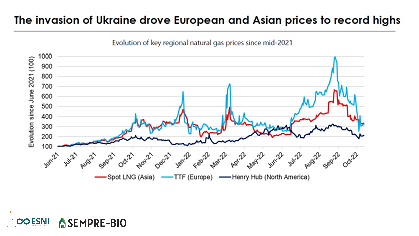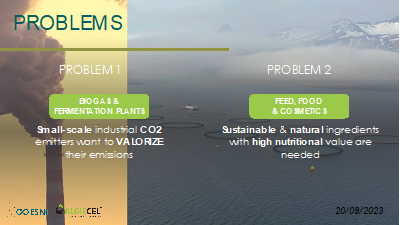
Algae are a vital group of aquatic photosynthetic organisms that when industrially produced, assimilate carbon and nutrients to produce “green” biomass feedstocks that can be used as a resource for various consumer products such as food, feed and cosmetics.
Algal growth requires CO2 and nutrients, and a promising aspect of microalgal cultivation is to combine it with waste streams which provide these nutrients. In the simplest form, this could be recycled nutrients from the downstream processing of the algal feedstock or more general sources such as industrial side streams or liquid digestate from biogas production or agriculture. More efficient use of these waste streams would be a big step towards developing a circular bioeconomy.
Bioremediation of wastewater, be it industrially or domestically sourced, is a mature industrial sector, connected closely with utility services, operating globally for decades. Apart from utilities, effluent content can be used in the production of energy, materials, and sometimes agricultural products. Bioremediation technologies use biological methods such as bacterial fermentation, and more recently algae were used to clean wastewater. Which have been proven at a commercial scale (Aqualia, CLEANRAS). Additionally, many projects have demonstrated algae bioremediation in the past (SABANA, AllGas, ALG-AD, EnAlgae), and current projects are now applying more systems thinking (CIRCALGAE, LOCALITY, REALM, AlgaeProBanos).
ESNI Conference 2023 | Workshops
Having said that, during the ESNI Conference 2023 on 20 September two algae workshops took place, involving seven panel speakers (presentation and panel discussions).
The first workshop “Standardise algae circular products to market in agricultural applications” was organised by EU4Algae and SEMPRE-Bio projects. The panel speakers were:
-
Marcella de Souza, Uni Ghent (BE) (PP in the SEMPRE-Bio project)
-
Efthalia Arvaniti, s.Pro/SUBMARINER Network (EU4Algae, AlgaeProBanos)
-
Robert Reinhardt, Algen SL (PP in the BioRURAL, LOCALITY project)
-
Marie Lambert, Flanders Food BE (LP of the LEMNAPRO project)
-
Leen Bastiaens, VITO BE (LP of the IDEA project)
The second workshop “Bringing to market high-quality green, healthy food, feed and cosmetics from algae…with a twist” was organised by AlgaeProBanos. The panel speakers were:
-
Reut Shavit, Algiecel DK (AlgaeProBanos)
-
Jonas de Cooman (PROVIRON BE)
-
Jean Paul Cadoret, Algama FR (RedWine)
-
Efthalia Arvaniti, s.Pro/SUBMARINER Network (EU4Algae, AlgaeProBanos)
When it comes to the workshop's report, the following was observed on the matters of Imports, Climate, Sustainable ingredients, Technology state of play & expectations, and Marketing strategies:
Imports
Production of nitrogen fertilisers consumes substantial amounts of energy, specifically natural gas (1% of world energy). In the EU, natural gas is imported from countries like Russia, while prices due to the Ukrainian war have recently risen to record-high levels.
On the other hand, phosphorus is imported from overseas and is driven from a phosphate mineral rock, an unsustainable resource categorised as ‘critical’ for humanity. To reduce imports and increase the sustainability of the system, the production of nitrogen and phosphorus fertilisers locally by recycling local nutrients e.g., from manure, AD digestate or other industrial side streams would be preferred.
The Biomethane strategy aims for the EU to produce annually 35 billion cubic meters by 2030, which will reduce Europe's dependency on natural gas from Russia in a cost-effective way. In Europe there are thousands of Biogas plans – in Italy alone there are 2,000 units. Digestate is a main co-product, and the liquid fraction of the digestate has been used for decades as biofertilisers. However, currently, there isn’t an EU digestate strategy, and its use in other sectors is still full of question marks.
Climate
Carbon capture in the form of CO2, is a key measure for reducing GHG emissions with photosynthetic plants and bacteria, including algae, being the main biological source of carbon sequestration in the natural system. Industrial carbon capture and storage (CCS) systems rely on transport from emitters and storage of CO2 deep underground in geological formations. Many countries see carbon capture and storage (CCS) technology as key to reaching the GHG emission targets for 2050. Hence why industrial microalgae can be a technology solution to capture carbon emissions at the source and convert them into valuable biomass containing nutrients, energy, and materials, suitable for food, and biobased products. To this end, carbon accounting at the life-cycle level and blue carbon credits would be needed. A few companies are looking at carbon capture in Europe. Algiecel based in Denmark is currently developing a plug-and-play solution for emitters to capture emissions of industries on sight with internalising carbon credits in their business model.
Sustainable ingredients
To achieve a green transition towards a more sustainable healthier and more resilient Europe, there is the need to further adapt to good practices, products and systems that prove to deliver impacts. Consumers are more informed about the environment and health and are adding extra pressure on companies to produce more healthy natural products with a low environmental footprint. Based on this, healthy lifestyles, including organic and vegetarian/vegan markets, have emerged. The alternative protein e.g., meat replacing markets could benefit from algae which can have up to 65% protein content depending on the species.
Technology state of play & expectations
Digestate allows algae production. Other good sources of nutrient-rich media, suitable for algae production apart from digestate, are industrial side-steams, e.g., from food processing, aquaponics, or RAS aquaculture. Algae produced from circulated nutrients is an added-value product in the market that is without impurities, and it is suitable as a high-quality biofertiliser (low-value product) and crop biostimulant (medium-value product). Furthermore, there is enormous potential in the production of algae foods, and there is substantial ongoing research linking cross-cutting value chains of circular nutrients and carbon with algae-based for food, feed, and cosmetic applications, see e.g., the HEU projects RedWine, Locality, AlgaeProBanos.
From a technical perspective, using circular nutrients mixed media, and not defined synthetic media, for algae production, is a biologically compatible process but as many biological systems using complex media, the photobioreactor (PBR) system needs an adaptation/acclimation period of the algae culture to reach a steady state (SEMPREBIO project). The lack of mapping and standardisation of ‘side-streams’ is not yet developed, which means that the industry is sceptic about using such streams as resources for nutrient media. Currently, in Europe, there are a few good practices with algae at scale, such as Aqualia/CICLANA. Moreover, there are a lot of research projects trying to commodify wastewater from different industries, such as agriculture (LOCALITY, REALM, Ultimate), and RAS aquaculture (TETRAS).
There is currently a generation shift in mentality from established wastewater treatment bioremediation solutions to developing sustainable design systems (circular economy). This changes fundamentally social and industrial symbiosis, cooperative approaches, investment, and ownership. Thus, algae can be a key part of a bigger revolution in water, nutrient, and energy management. However, apart from legislation for enabling side-streams to be safely used/recycled in biomass production and product development, the regulators first, followed by society, need to change their perception about what is defined as ‘wastewater’, as it is a negative label and an umbrella term that legally and emotionally puts many different types of resources in a single waste basket. There are many different side-streams e.g., food processing, that could be easily recycled and safely used as nutrient media for algae production. Distinction and analysis in a glossary with definitions of water, wastewater, and biowaste sources will eventually clarify expectations and unearth needs for standardisation in the industry.
Finally, unlike earlier years of algae hype (2000-2009) where the market had crashed from disillusioned expectations of technology, now expectations are in line with technology adoption, which means there is an evident increase and alignment of trust by investors and up takers alike.
Marketing strategies
Algae can provide feed ingredients to substitute fish oil and protein fish meal in the e.g., salmon industry. This means that algae are an upcoming resource for the feed industry, and if upscaled, they could help reduce sea over-fishing for fish feeds, and also reduce feed imports, such as soybean, that cause major environmental disturbance issues.
In addition to feed ingredients, microalgae have been proven in the feed additives market as having bioactive properties that improve the health of farmed fish. Aligned with this view, the Belgian company PROVIRON is successfully using algae to feed youngsters. However, more bioactive health and sustainability claims are expected to be submitted in the next years as due to the lack of product standards or insufficiency thereof, many markets, including feed, biofertiliser, and biostimulants, it was commonly agreed that marketing is still based on company reputation.
More initiatives promoting the recycling of nutrients instead of importing soybeans from overseas are needed.
Additional information
Join the #EU4Algae conversation and don’t forget to keep an eye on the EU4Algae Forum to stay updated and learn more about the ongoing activities, initiatives and updates on the development of the EU4Algae Forum online.
To contact us, please use the following email: contact eu4algae [dot] eu (contact[at]eu4algae[dot]eu).
eu4algae [dot] eu (contact[at]eu4algae[dot]eu).
Details
- Publication date
- 19 April 2024
- Author
- Directorate-General for Maritime Affairs and Fisheries




